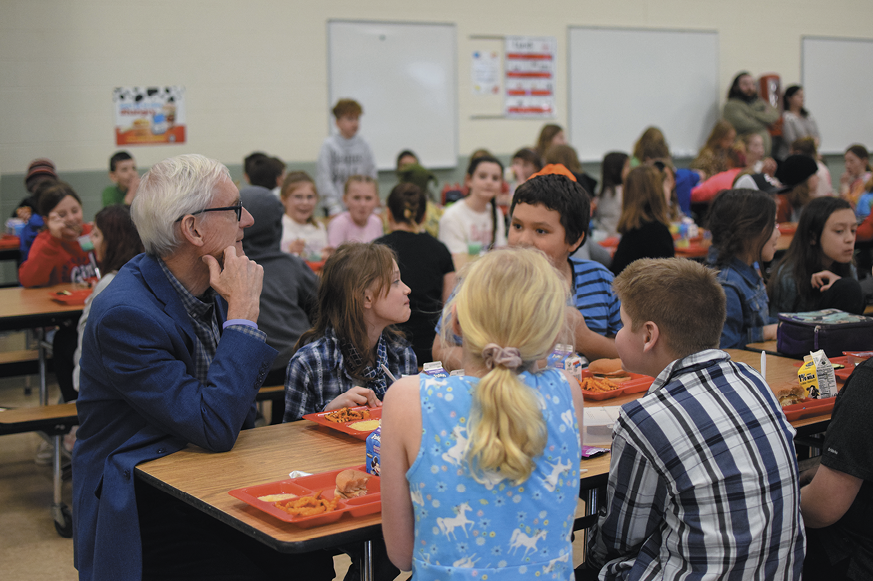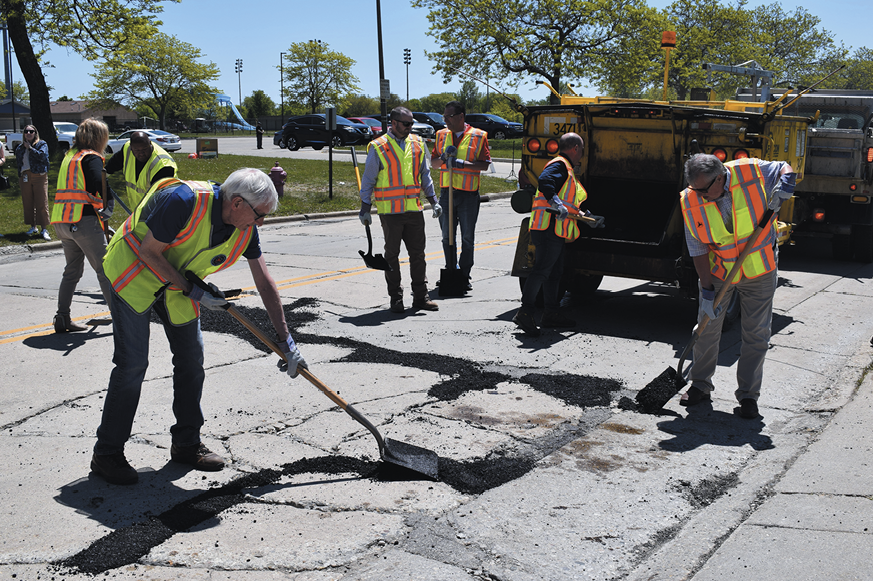- Home
- Media Kit
- MediaJet
- Current Issue
- Past Issues
- Ad Specs-Submission
- Reprints (PDF)
- Photo Specifications (PDF)
- Contact Us
- PRIVACY POLICY
- TERMS OF USE
![]()
ONLINE
![]()
ONLINE

Meeting The Needs
Of The 21st Century
Editors’ Note
On November 6, 2018, the people of Wisconsin voted Tony Evers the 46th governor of Wisconsin. Four years later, on November 8, 2022, Wisconsinites re-elected him as governor. Prior to his election in 2018, Evers served as the Wisconsin State Superintendent of Public Instruction, winning statewide elections in 2009, 2013, and 2017. With over three decades of public education experience, Evers has spent most of his life fighting for Wisconsin’s kids. He began his career in education, first as a science teacher in Baraboo before going on to serve families, students, and communities across the state, including in Tomah, Oakfield, Verona, and Oshkosh. Born and raised in Plymouth, Wisconsin, Evers graduated from Plymouth High School and earned his bachelor’s, master’s, and doctoral degrees from the University of Wisconsin-Madison.

Governor Tony Evers chats with kids at Mount Horeb
Intermediate School in Mount Horeb, Wisconsin,
during Public Schools Week
What attracted you to public service?
Public service means a great deal to me – not just as governor, but also as a born-and-raised Wisconsinite. I grew up surrounded by healthcare workers, and I always wanted to follow in their footsteps and help people just like they did. Ultimately, that path ended up with me spending most of my life in education – first as a science teacher, then I became a principal, a superintendent, and the state superintendent – living and working in communities across our state.
To me, public service has always been about helping people, being a good neighbor and a good citizen, and doing what I can to give back to the community and the state that raised me and made me who I am today. And I’m proud that’s led to about 50 years of serving the great state of Wisconsin.
Will you discuss your administration’s efforts to improve education in Wisconsin and reform K-12 education?
I’ve always believed that doing what’s best for our kids is what’s best for our state. I’ve spent most of my life fighting for Wisconsin’s kids and schools, first as a science teacher, then later as a principal and state superintendent, and now as governor. Supporting and investing in our kids and our schools and improving outcomes to ensure our kids are successful both in and out of the classroom has been a central focus of my public service and my administration.
After years of disinvestment in education under the previous administration, I’ve signed three consecutive state budgets that provided historic investments in education at every level by increasing funding for special education, school mental health, sparsity aid for rural schools, and school transportation costs. The most recent budget I signed provided more than $1 billion in spendable revenue for K-12 schools – that’s money that can be used in the classroom for our kids. I was also proud to use my broad constitutional veto authority to ensure school districts will have continued, additive per pupil revenue adjustments of $325 every year for the next 400 years, providing districts with a level of predictable, long-term spending authority increases that they have not experienced in more than a decade.
One issue impacting our kids and our schools that I’ve been particularly concerned about is the mental health crisis facing our youth. According to the latest report from the Wisconsin Office of Children’s Mental Health, kids continue to report highly concerning levels of anxiety, depression, self-harm, and suicidal thoughts – and that’s especially true for teen girls, students of color, and LGBTQ kids. That was a large part of my decision to declare 2023 the Year of Mental Health, and it’s why I fought hard to secure $30 million in the most recent budget to continue support for school-based mental health programs statewide.
Whether it’s making sure kids have access to mental health services, ensuring kids aren’t hungry at school so they can focus on their coursework, helping with increased costs of classroom and school supplies due to national inflation, or retaining and recruiting educators and staff to keep class sizes small, we’ve made significant progress in doing what’s best for our kids and ensuring our schools have the tools to provide every kid a high-quality education. But we also know that much work remains, and we’re not letting up anytime soon.

Governor Tony Evers fills potholes in Kenosha, Wisconsin,
on his annual “Pothole Patrol” tour
How is your administration preparing Wisconsin for the 21st Century by expanding high-speed, affordable internet and fixing roads and infrastructure?
We’re working hard to ensure Wisconsin has the infrastructure, workforce, and economy to meet the needs of the 21st Century. We have to have reliable and affordable high-speed internet, good roads and bridges, accessible transit and transportation alternatives, and sustainable, resilient infrastructure in Wisconsin – these are all key to our state’s and our economy’s future success.
No administration in Wisconsin’s history has done more to expand access to high-speed internet than my administration has because we know that nearly everything about our economy, our workforce, and our way of life in the 21st Century depends upon it. And the longer it takes to get everyone connected, the more costly it will become for our state to catch up.
I created the Governor’s Task Force on Broadband Access and declared 2021 the Year of Broadband Access, and we’ve worked to deliver historic investments in broadband expansion over the last four years. I’m proud that with our state budget investments and the federal relief funds I’ve directed to broadband expansion, we are helping more than 400,000 homes and businesses get new or improved broadband services across the state.
Additionally, through President Joe Biden’s Bipartisan Infrastructure Law, we are expecting to receive more than $1 billion in federal funds to continue our efforts to ensure every Wisconsinite has access to reliable, affordable, high-speed internet.
When it comes to our roads and bridges, I ran for governor promising to fix the damn roads, find a long-term, sustainable solution to our transportation funding crisis, and invest in building 21st-century infrastructure to create stronger, more inclusive, and well-connected communities.
And we’ve gotten to work delivering on this promise. Since 2019, my administration has repaired and improved over 7,424 miles of roads and 1,780 bridges, including over 900 miles of road and over 200 bridges last year alone. We also worked with Minnesota and federal partners, including U.S. Sen. Tammy Baldwin, to secure another $1 billion in federal funding through the Bipartisan Infrastructure Law to replace the Blatnik Bridge in Superior, which is a critical economic driver and supports the largest port on the Great Lakes.
With so much gridlock and partisanship in Washington DC, what do you see as the key ingredients in getting action and achieving results?
It’s no secret that folks on either side of the aisle don’t always agree on every issue all the time, especially in Washington DC. But, for me, it always comes down to trying to do the right thing for Wisconsin and the people of our state. So, I’m proud that even though Republicans have had a supermajority and near-supermajority, respectively, in the Wisconsin State Legislature, we’ve still been able to find common ground and bridge partisan divides to deliver huge wins for Wisconsinites across our state.
This past year, for example, we worked together to enact some of our most important work yet. We passed significant bipartisan legislation to provide a generational increase in state support for local governments. Our most recent bipartisan budget made one of the largest investments in affordable housing in state history. And we were able to pass historic legislation to keep the Milwaukee Brewers and Major League Baseball in Wisconsin through 2050, ensuring future generations will grow up rooting for the home team just as so many of us have.
Most recently, I was proud to sign new, fair legislative maps that passed through the Wisconsin State Legislature with bipartisan support. That’s something most folks in our state never thought would be possible, but we focused on doing the right thing for the people of Wisconsin – and not any one political party or politician – and we got it done. Wisconsin isn’t a red or blue state – we’re a purple state – and now our maps will reflect this basic fact.
I always like to remind people that, despite what some people would have them believe or what gets covered on the news, there is a lot of bipartisan work happening in the State Capitol building, from addressing reckless driving to supporting our farmers and agricultural exports to bolstering financial literacy in schools statewide. I usually surprise people when I tell them that I actually end up signing far more bills than I veto each legislative session under divided government. I know it’s usually the vetoes that garner the most amount of news attention, but at the end of the day, I think we’ve been able to show that we can accomplish big things when elected officials put politics, partisanship, and egos aside and choose to do the right thing for our state and the people we serve.
With the success that your administration has achieved for Wisconsin, are you able to enjoy the process and take moments to celebrate the wins?
Absolutely. Working in a divided government, which we’ve done for the last five years, you learn to celebrate your wins every chance you get, especially when we’re able to work together in a bipartisan fashion to get things done. Any time we can do the right thing, find a solution to fix a problem, or make government work better for the people of this state, that’s a win in my book.
For example, I’ve been celebrating Wisconsin’s new, fair legislative maps that I signed into law in February. For the first time in over a decade, Wisconsin is no longer living under some of the most gerrymandered legislative maps in America. This is a big deal and a huge win for the people of our state, and something I’ve spent the last several years since I first ran for governor in 2018 fighting to secure.
I proposed legislative maps that the Wisconsin State Legislature adopted and passed with bipartisan support without any changes. Wisconsin’s new maps that I enacted are fair, responsive, and reflect the will of the people. Under these maps, we’ll see more competitive, contested races by making it more likely that legislative districts will flip from one party’s control to another when voters’ preferences change – that’s common sense, and it’s how our elections should work.
With these new, more competitive maps, elected officials on both sides of the aisle will actually have to listen and do what is best, not for their own political party, but for the people who elect them. I think we’ll see more compromise and good-faith efforts to work together and across the aisle, and we’ll be able to get some great things done for the people of Wisconsin. I’m hopeful we’ll finally be able to enact popular policies that we know have bipartisan support like Medicaid expansion, expanding paid family leave, and commonsense gun safety measures.
So, that’s something we’ve been celebrating and something I’m pretty jazzed about, and I always try to be present and take it in when we have historic moments and victories like these. I have the best job, and I feel fortunate every day to serve the state that made me who I am today.![]()